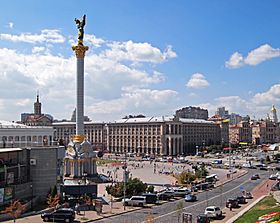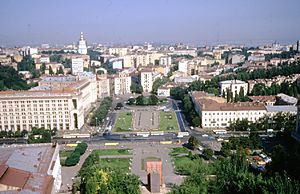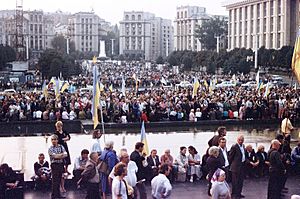Maidan Nezalezhnosti facts for kids

View of Maidan Nezalezhnosti in 2013 before Euromaidan; the Independence Monument in the foreground
|
|

Location within Kyiv
|
|
| Location | Kyiv, Ukraine |
|---|---|
| Coordinates | 50°27′0″N 30°31′27″E / 50.45000°N 30.52417°E |
Maidan Nezalezhnosti (which means Independence Square in Ukrainian) is the main town square in Kyiv, the capital city of Ukraine. It is one of the most important squares in the city. You can find it on Khreshchatyk Street in the Shevchenko area. The famous Independence Monument stands tall in the square.
For a long time, this square has been a key place for public gatherings. Since Ukraine became independent in 1990, it has hosted many important political events. These include big protests like the 1990 student Revolution on Granite and the 2004 Orange Revolution. The 2013–14 Euromaidan protests also took place here.
After 2014, some fun events like Christmas Fairs moved to Sofiyivska Square. This was because the square became a place of remembrance for those who lost their lives during the Euromaidan events.
Contents
What's in a Name?
The square got its current name, Maidan Nezalezhnosti, on August 26, 1991. This was just two days after Ukraine declared its independence. This happened as the Soviet Union was coming to an end.
The word Maidan means 'square' or 'open space' in Ukrainian. This word is also used in many places in the Middle East and South Asia. It comes from the Persian word meydân, which means 'town-square'.
Maidan Nezalezhnosti is special because it's the only square in Kyiv officially called a "Maidan." Other squares in Kyiv are usually called "Ploshcha," which is another Ukrainian word for 'square'.
Here's how the square's name has changed over time:
- 1869: Khreshchatyk Square
- 1876: Duma Square
- 1919: Soviet Square
- 1935: Kalinin Square
- 1941: Duma Square
- 1943: Kalinin Square
- 1977: October Revolution Square
- Since 1991: Independence Square (Maidan Nezalezhnosti)
Other cities in Ukraine also have squares named Maidan Nezalezhnosti. These include Khmelnytskyi and Sumy.
Where is it Located?
Independence Square is one of three squares along Khreshchatyk Street. It's near European Square, which is at the end of Khreshchatyk.
Khreshchatyk Street actually divides the square in half. Many other streets also lead to the square. These include Architect Horodecki Street, Institute Street, and Michael Street.
The square has different levels. At ground level, you'll find the busy intersection of Khreshchatyk. Below the square, there's a Kyiv Metro station called Maidan Nezalezhnosti. There's also an underground shopping mall called "Hlobus" (or "Globus").
A Look Back: History of the Square
Early Days and Tsarist Russia
Long ago, before the 10th century, this area was called Perevisyshch. It was just outside the old city of Kyiv.
One of the main gates of Old Kyiv was here, called the Lyadski Gates. These gates were destroyed in 1240 by the Mongol army. Later, in the 18th century, new Pecherski Gates were built.
Until the early 1800s, the area was a low, empty space known as Goat Swamp. In the 1830s, the first wooden houses appeared. By the 1850s, stone buildings were built. The famous Ukrainian writer, Taras Shevchenko, even lived nearby in 1859.
The area grew quickly in the mid-1800s. It became a busy business center for Kyiv. In 1876, the Kyiv City Duma building (city council) was built here. The square then became known as Duma Square. An electric tram line, the first in the Russian Empire, reached the square in 1894.
In 1913, a monument to Pyotr Stolypin, a Russian prime minister, was placed in front of the City Duma. It was removed in 1917 during a time of revolution.
Soviet Times Before World War II
In 1919, the square was renamed Soviet Square. From 1935, it was called Kalinin Square, named after Mikhail Kalinin, a Soviet leader. Much of the square was destroyed during World War II.
Soviet Times After World War II
After the war, the square was completely rebuilt. It was designed in a style called Stalinist architecture, matching the new Khreshchatyk Street. The Kyiv Central Post Office and the Trade-Union House with its tall clock became well-known buildings in the square.
In 1976–77, the square was rebuilt again as part of metro construction. It was renamed October Revolution Square. A large monument for the 60th anniversary of the October Revolution was added, along with many fountains.
During the Soviet era, the square was used for big parades and demonstrations. These celebrated holidays like May 1 and Victory Day.
Independent Ukraine
After Ukraine became independent in 1991, the square received its current name, Maidan Nezalezhnosti. This name celebrates Ukraine's freedom.
In 2001, the square was a main spot for the "Ukraine without Kuchma" protests. The mayor of Kyiv ordered a big renovation of the area. Some people thought this was to stop the protests.
After the renovation, the square looked very different. It now features monuments to the legendary founders of Kyiv: Kyi, Shchek, Khoryv and Lybid. There's also a statue of the folk hero Cossack Mamay and the city's protector, Archangel Michael. The Independence Monument is topped by the goddess Berehynia. Many glass domes are also a modern part of the square.
An underground shopping mall called Globus was built under the square. It replaced an old underpass. The Trade-Unions House was badly damaged in a fire in February 2014 and has since been rebuilt.
A Place for Change: Political Activity
As Kyiv's main square, Maidan Nezalezhnosti has been a center for political events since the Soviet era ended.
In 1990, student protests and hunger strikes, known as the Revolution on Granite, happened here. These protests led to the resignation of a top Ukrainian official.
In the 2000s, the biggest political protests in Ukraine took place in this square. These included the Ukraine without Kuchma campaign and the Orange Revolution in late 2004. During the Orange Revolution, hundreds of thousands of protesters gathered. They set up tents and stayed for weeks, even in the cold and snow. These protests were against electoral fraud (cheating in elections). They led to a new presidential election, which was won by the opposition candidate, Viktor Yushchenko.
After the Orange Revolution, Maidan Nezalezhnosti continued to attract protesters. Large rallies for political candidates have brought huge crowds. For example, nearly 200,000 people gathered in 2009 for a political party meeting.
The square was also the site of the Euromaidan protests, which started in November 2013. These protests grew into violent clashes and fires. They ended with the February Revolution of Dignity. Protesters stayed in the square day and night. Sadly, during the Revolution of Dignity, many people lost their lives.
Since the Russian invasion of Ukraine, a special memorial has been set up in the square. It honors those who have died in the conflict. In 2025, a funeral ceremony for journalist Victoria Roshchyna was held here.
Important Sights
Current Landmarks
- Monument to the Founders of Kyiv
- Independence Monument: A tall column celebrating Ukraine's independence in 1991. It has the protectoress Berehynia on top.
- Lach Gates: A monument marking the historic gates.
Former Landmarks
- Monument to Pyotr Stolypin
- Bust to Karl Marx
- Monument to the Great October (a statue of Lenin)
Important Buildings
- "Hlobus" (or "Globus") underground shopping mall
- Tchaikovsky National Music Academy of Ukraine
- Hotel Ukraine
- Building of the Trade Unions Federation of Ukraine
- Central Post Office
- Information and Exhibition Centre of the Maidan Museum
Images for kids
-
Maidan Nezalezhnosti, 2013, before Euromaidan.
See also
 In Spanish: Plaza de la Independencia (Kiev) para niños
In Spanish: Plaza de la Independencia (Kiev) para niños
- Euromaidan
- Orange Revolution
- Ukraine without Kuchma











